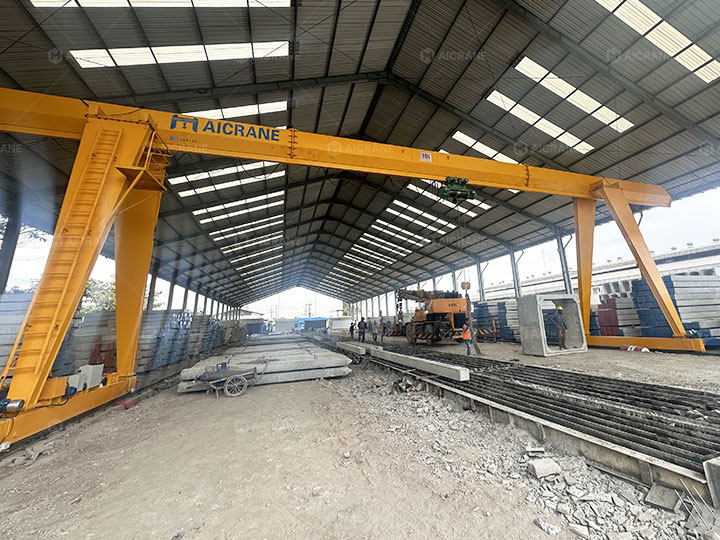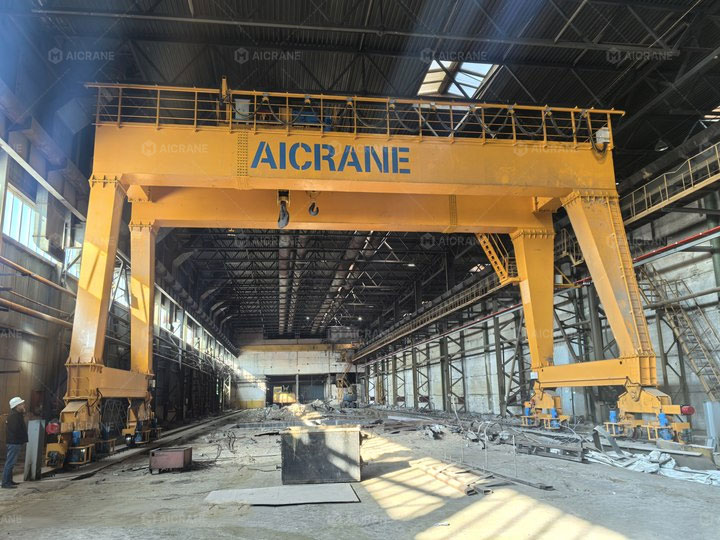Gantry cranes are vital pieces of equipment widely used in industries such as construction, manufacturing, shipping, and logistics for lifting and moving heavy loads. They are especially useful in outdoor settings or where overhead crane runways are not practical. Among the various types of gantry cranes, single girder and double girder gantry cranes are the most commonly used. Understanding their design differences is essential for selecting the right crane based on application needs, operational efficiency, cost considerations, and structural requirements.
In this article, we’ll explore in detail the design differences between single and double girder gantry cranes, including structural composition, lifting capacity, span and lifting height, operational speed, cost, and ideal applications.

1. Structural Design Differences
The primary difference between a single girder and a double girder gantry crane lies in the number of main beams (or girders) that support the trolley and hoist.
Single Girder Gantry Crane:
A single girder gantry crane for sale consists of one horizontal main beam that supports the hoist. The hoist is typically mounted on the bottom flange of the girder and runs along it. The supporting legs of the crane are connected directly to the girder on either side, forming a straightforward structure.
Key structural features:
-
One girder supports the load.
-
Hoist typically mounted under-running on the bottom flange.
-
Lighter and simpler construction.
-
Easier and quicker to fabricate and install.
Double Girder Gantry Crane:
A double girder gantry crane features two parallel girders that form a box structure. The hoist or trolley travels on rails installed on the top of these girders. The end carriages or supporting legs connect beneath or between the girders.
Key structural features:
-
Two girders support the load and provide additional strength.
-
Hoist mounted top-running on rails between the girders.
-
Heavier and more complex structure.
-
Increased rigidity and stability.

2. Lifting Capacity
Another critical difference between the two types lies in their lifting capacities, which determine their suitability for specific industrial tasks.
-
Single girder gantry cranes are generally suitable for light to medium-duty applications, with typical lifting capacities ranging from 1 ton to 20 tons. Some designs may allow slightly higher capacities, but they are not ideal for extremely heavy loads.
-
Double girder gantry cranes are designed for heavy-duty lifting. These heavy duty gantry cranes can support significantly higher load capacities, often ranging from 20 tons up to 500 tons or more, depending on the specific configuration and engineering design.
Thus, for operations involving very heavy loads, such as lifting steel coils, precast concrete sections, or machinery, double girder gantry cranes are the preferred choice.
3. Span and Lifting Height
The span (distance between the crane legs) and lifting height (maximum vertical distance the hook can travel) are key parameters that differ significantly between the two designs.
-
Single girder cranes are more suitable for shorter spans and lower lifting heights. The under-slung hoist design naturally limits the available hook height, making them more appropriate for smaller workspaces or applications where vertical clearance is limited.
-
Double girder cranes, with their top-running hoist design, allow for greater lifting height and can accommodate longer spans, often up to 35 meters or more. This makes them ideal for wide working areas or where maximum vertical lift is necessary.
4. Hoist and Trolley Configuration
-
Single girder cranes typically use standard hoists that are simpler and lighter. These hoists are suspended under the girder and are cost-effective for small to medium load applications.
-
Double girder cranes utilize custom-engineered hoist-trolley systems, which can handle larger loads and travel at higher speeds. The trolley usually moves on rails mounted atop the girders, allowing for a more stable and balanced operation.
Additionally, double girder trolleys can incorporate more advanced features such as maintenance platforms, auxiliary hoists, and walkways, which are difficult or impractical to implement in single girder systems.
5. Crane Speed and Performance
Double girder gantry cranes generally offer higher operating speeds, both for hoisting and trolley movement. The dual girder structure provides superior rigidity, which allows faster and smoother operations even under heavy loads.
Single girder light duty gantry cranes, while slower in operation, are more energy-efficient and simpler to control. For operations that do not require fast load handling or involve lighter materials, single girder cranes can provide sufficient performance.
6. Cost and Installation
Cost:
-
Single girder gantry cranes are typically more cost-effective due to their simpler design, lighter weight, and lower material and manufacturing costs.
-
Double girder gantry cranes involve higher initial investment owing to more material use, complex fabrication, and additional components like rails, walkways, and control systems.
Installation:
-
Single girder cranes are easier to transport and install, making them ideal for temporary sites or small workshops.
-
Double girder cranes require more installation time and effort, often involving precise alignment and structural reinforcements, especially for large-span cranes.
7. Maintenance and Durability
-
Single girder cranes, having fewer components, are easier to maintain but may experience quicker wear and tear when used near their maximum capacity for prolonged periods.
-
Double girder cranes are more durable and robust, especially in demanding environments like steel mills, shipyards, or power stations. Their superior strength and stability make them suitable for continuous operation under heavy loads.
8. Applications
Typical Applications for Single Girder Gantry Cranes:
-
Light manufacturing
-
Maintenance workshops
-
Small warehouses
-
Construction sites
-
Material handling in small fabrication shops
Typical Applications for Double Girder Gantry Cranes:
-
Heavy manufacturing (steel, cement, machinery)
-
Precast concrete plants
-
Shipbuilding and ship repair yards
-
Power generation plants
-
Container handling and port terminals
-
Rail yards and industrial outdoor areas
Conclusion
When selecting between a single and double girder gantry crane, it’s important to consider the operational requirements, load capacity, working environment, and budget constraints.
-
Single girder gantry cranes are ideal for light-duty applications where space, cost, and simplicity are the priorities. They are compact, easy to install, and efficient for smaller tasks.
-
Double girder gantry cranes, on the other hand, offer high strength, better hook height, and wider spans, making them indispensable for demanding and heavy-duty operations.
Understanding these design differences helps industries make informed choices that align with their operational goals, ensuring safety, productivity, and long-term cost-effectiveness. Whether you’re upgrading your material handling system or setting up a new facility, the right crane design plays a crucial role in maximizing performance and return on investment.